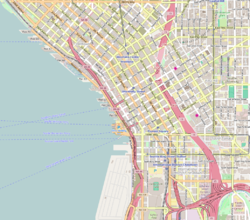
Pioneer Square is a neighborhood in the southwest corner of Downtown Seattle, Washington, US. It was once the heart of the city: Seattle's founders settled there in 1852, following a brief six-month settlement at Alki Point on the far side of Elliott Bay. The early structures in the neighborhood were mostly wooden, and nearly all burned in the Great Seattle Fire of 1889. By the end of 1890, dozens of brick and stone buildings had been erected in their stead; to this day, the architectural character of the neighborhood derives from these late 19th century buildings, mostly examples of Richardsonian Romanesque.

Tully's Coffee is an American specialty coffee manufacturing brand owned by Keurig Dr Pepper, which acquired Tully's brand and wholesale business in 2009.

Union Square is a historic intersection and surrounding neighborhood in Manhattan, New York City, United States, located where Broadway and the former Bowery Road – now Fourth Avenue – came together in the early 19th century. Its name denotes that "here was the union of the two principal thoroughfares of the island". The current Union Square Park is bounded by 14th Street on the south, 17th Street on the north, and Union Square West and Union Square East to the west and east respectively. 17th Street links together Broadway and Park Avenue South on the north end of the park, while Union Square East connects Park Avenue South to Fourth Avenue and the continuation of Broadway on the park's south side. The park is maintained by the New York City Department of Parks and Recreation.

Greenwood is a neighborhood in north central Seattle, Washington, United States. The intersection of Greenwood Avenue North and North 85th Street is the commercial center. Greenwood is known for its numerous bars, restaurants, coffee houses, theatres and specialty stores. Greenwood's main thoroughfares are Greenwood Avenue North and North 80th and 85th streets.

Klondike Gold Rush National Historical Park is a national historical park operated by the National Park Service that seeks to commemorate the Klondike Gold Rush of the late 1890s. Though the gold fields that were the ultimate goal of the stampeders lay in the Yukon Territory, the park comprises staging areas for the trek there and the routes leading in its direction. There are four units, including three in Municipality of Skagway Borough, Alaska and a fourth in the Pioneer Square National Historic District in Seattle, Washington.
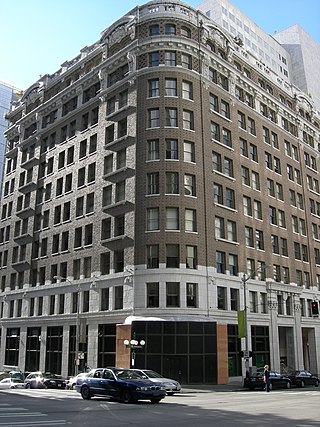
The Metropolitan Tract is an area of land in downtown Seattle owned by the University of Washington. Originally covering 10 acres (40,000 m2), the 1962 purchase of land for a garage for the Olympic Hotel expanded the plot to 11 acres (45,000 m2). The Metropolitan Tract is primarily located in a rectangle formed by Seneca St., Third Ave., Union St., and Sixth Ave.
Woodward & Lothrop was a department store chain headquartered in Washington, D.C. that began as the capital's first department store in 1887. Woodies, as it was often nicknamed, maintained stores in the Mid-Atlantic United States. Its flagship store was a fixture of Washington, D.C.'s downtown shopping district, competing with Garfinckel's and acquiring Palais Royal. The chain filed for bankruptcy in January 1994 and completed liquidation in November 1995, with most locations sold to either J. C. Penney or May Department Stores Company. The flagship building is a D.C. historic landmark that became the center of controversy over competing visions for DC's urban renewal after the chain's demise, and the former service warehouse in the city's northeast is also listed as a landmark.
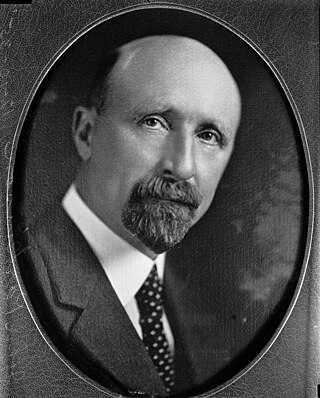
John and Donald Parkinson were a father-and-son architectural firm operating in the Los Angeles area in the early 20th century. They designed and built many of the city's iconic buildings, including Grand Central Market, the Memorial Coliseum and the City Hall.

Garfinckel's was a prominent department store chain based in Washington, D.C. that catered to a clientele of wealthy consumers. Its flagship store at 14th and F in the city's F Street shopping district is listed on the National Register. It filed for Chapter 11 bankruptcy in June 1990 and ceased operations that year.
Balducci's Food Lover's Market is a specialty gourmet food retailer in the Mid-Atlantic United States with eight grocery stores, owned by Albertsons since 2020.

The Peter Kirk Building, first known as the Kirkland Investment Company Building, is a historic building in Kirkland, Washington located at the corner of Market Street and Seventh Avenue, Kirkland's historic commercial core. It is listed on the National Register of Historic Places. It was built in 1889 by the city's founder and namesake Peter Kirk, who constructed the building as the intended centerpiece of his planned steel producing mecca until those plans were dashed by multiple factors including the Panic of 1893. In the ensuing years, Kirkland's commercial core shifted to the south, likely sparing the building the fate of urban renewal or being altered beyond recognition. Due to its location on the East Side's main north-south arterial the building remained occupied on the ground floor but had fallen into serious disrepair by the mid-20th century. The building was rescued from demolition in the early 1960s by a syndicate led by William Radcliffe who purchased and restored the Peter Kirk Building into the Kirkland Arts Center which it remains to the current day. Today it is one of Kirkland's most historic and iconic landmarks.

Ponce City Market is a mixed-use development located in a former Sears catalogue facility in Atlanta, with national and local retail anchors, restaurants, a food hall, boutiques and offices, and residential units. It is located adjacent to the intersection of the BeltLine with Ponce de Leon Avenue in the Old Fourth Ward near Virginia Highland, Poncey-Highland and Midtown neighborhoods. The 2.1-million-square-foot (200,000 m2) building, one of the largest by volume in the Southeast United States, was used by Sears, Roebuck and Co. from 1926 to 1987 and later by the City of Atlanta as "City Hall East". The building's lot covers 16 acres (65,000 m2). Ponce City Market officially opened on August 25, 2014. It was listed on the National Register of Historic Places in 2016.

Gay Street is a street in Knoxville, Tennessee, United States, that traverses the heart of the city's downtown area. Since its development in the 1790s, Gay Street has served as the city's principal financial and commercial thoroughfare, and has played a primary role in the city's historical and cultural development. The street contains Knoxville's largest office buildings and oldest commercial structures. Several buildings on Gay Street have been listed on the National Register of Historic Places.
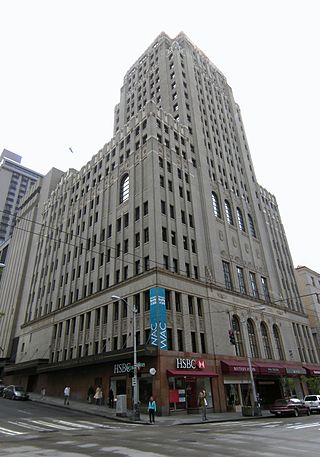
The Washington Athletic Club, founded in 1930, is a private social and athletic club located in downtown Seattle. The 21-story WAC clubhouse opened in December 1930, and was designed in the Art Deco style by Seattle architect Sherwood D. Ford.
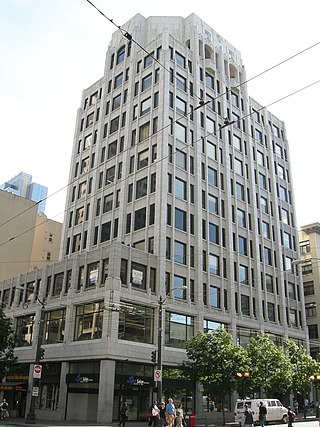
The Olympic Tower, originally known as the United Shopping Tower, then the Northwestern Mutual Insurance Building, and later, the Olympic Savings Tower, is a historic 12-story office tower located in Seattle, Washington and listed on the National Register of Historic Places. It was originally built in 1929 at the Southwest corner of Third Avenue and Pine Street for the United Pacific Corporation under the control of Seattle investment firm Drumheller, Ehrlichman and White. It was designed by Henry Bittman who also designed additions to the building in 1939.

The Globe Building, Beebe Building and the Hotel Cecil are a trio of historic office/hotel buildings located in Downtown Seattle, Washington, United States. The buildings occupy the entire west side of the 1000 block of 1st Avenue between Madison and Spring streets. The three buildings were constructed from late 1900 to 1901 for Syracuse-based investors Clifford Beebe and William Nottingham by the Clise Investment Company, headed by businessman James Clise (1855–1938), as a result of the Alaska Gold Rush which fueled the construction of many such buildings in downtown Seattle.

The National Building is a historic warehouse building in downtown Seattle, Washington, located on the east side of Western Avenue between Spring and Madison Streets in what was historically Seattle's commission district. It is now home to the Seattle Weekly. It is a six-story plus basement brick building that covers the entire half-block. The dark red brick facade is simply decorated with piers capped with small Ionic capitals and a small cornice, which is a reproduction of the original cornice. Kingsley & Anderson of Seattle were the architects.

The Hull Building is a historic commercial building located at 2401-2405 1st Avenue in the Belltown neighborhood of Seattle, Washington. Designed by notable Northwest architect Elmer Fisher, It was constructed in the latter half of 1889 as an investment property by Seattle politician Alonzo Hull (1843-1929) and was added to the National Register of Historic Places on January 27, 1983. It is adjacent to the Battery Street Tunnel's south portal.

Onni Group is primarily a real estate development company, headquartered in Vancouver. The company has built a variety of residential, commercial, and rental projects across Canada and the United States for various uses. The company started investing in the US in 2010 by acquiring apartment properties in Phoenix. Since its initial investments in the US, the Onni Group has become one of LA's biggest developers.

The Mutual Life Building, originally known as the Yesler Building, is an historic office building located in Seattle's Pioneer Square neighborhood that anchors the West side of the square. The building sits on one of the most historic sites in the city; the original location of Henry Yesler's cookhouse that served his sawmill in the early 1850s and was one of Seattle's first community gathering spaces. It was also the site of the first sermon delivered and first lawsuit tried in King County. By the late 1880s Yesler had replaced the old shanties with several substantial brick buildings including the grand Yesler-Leary Building, which would all be destroyed by the Great Seattle Fire in 1889. The realignment of First Avenue to reconcile Seattle's clashing street grids immediately after the fire would split Yesler's corner into two pieces; the severed eastern corner would become part of Pioneer Square park, and on the western lot Yesler would begin construction of his eponymous block in 1890 to house the First National Bank, which had previously been located in the Yesler-Leary Building. Portland brewer Louis Feurer began construction of a conjoined building to the west of Yesler's at the same time. Progress of both would be stunted and the original plans of architect Elmer H. Fisher were dropped by the time construction resumed in 1892. It would take 4 phases and 4 different architects before the building reached its final form in 1905. The Mutual Life Insurance Company of New York only owned the building from 1896 to 1909, but it would retain their name even after the company moved out in 1916.

